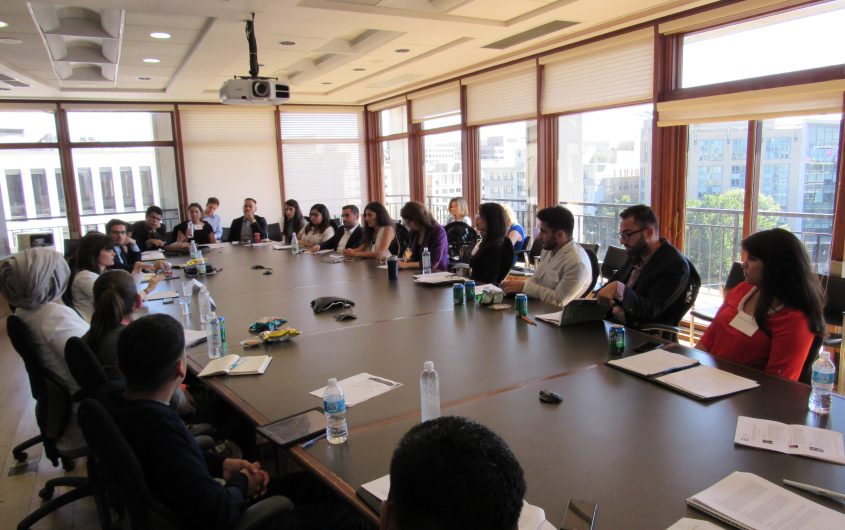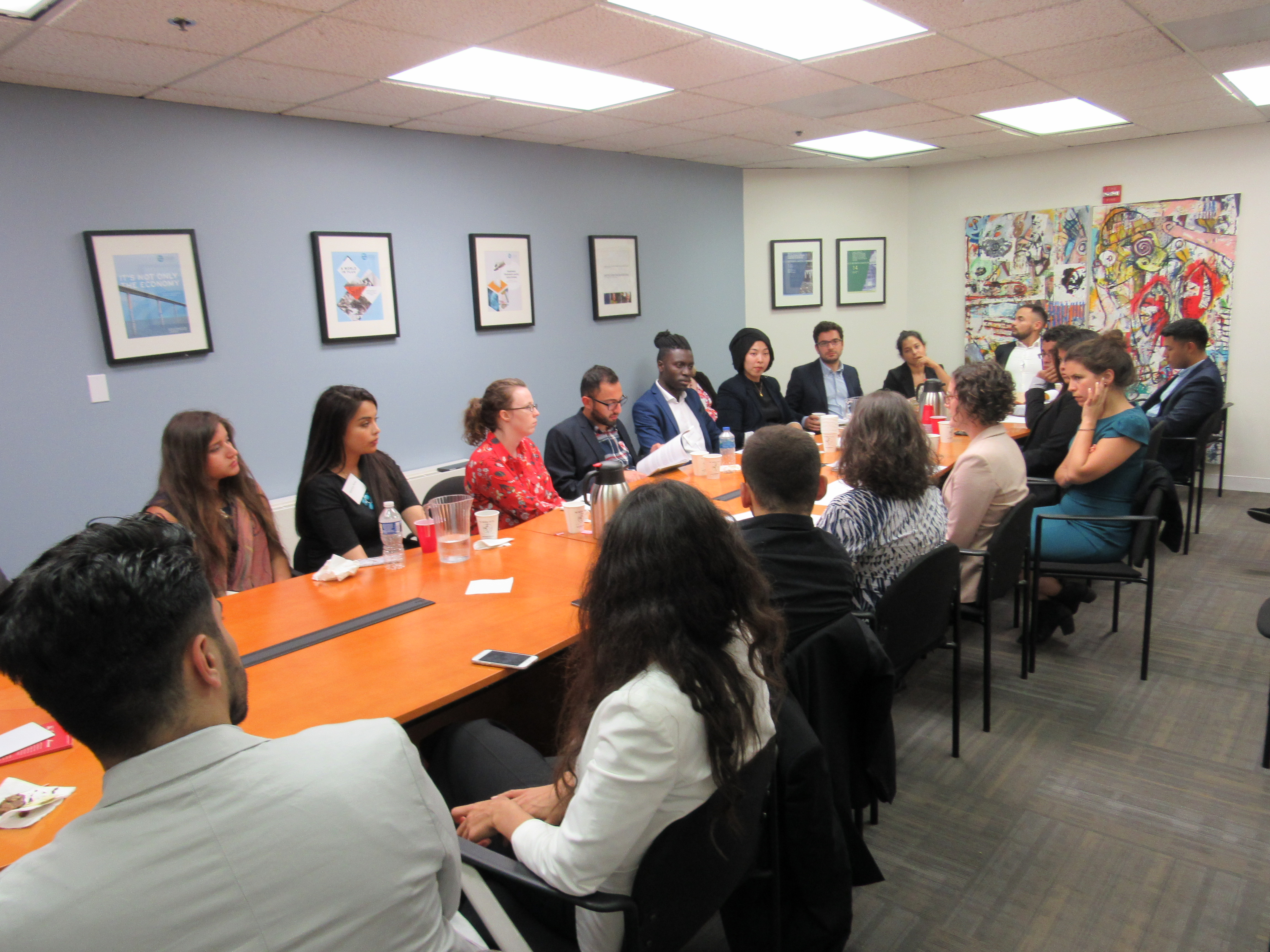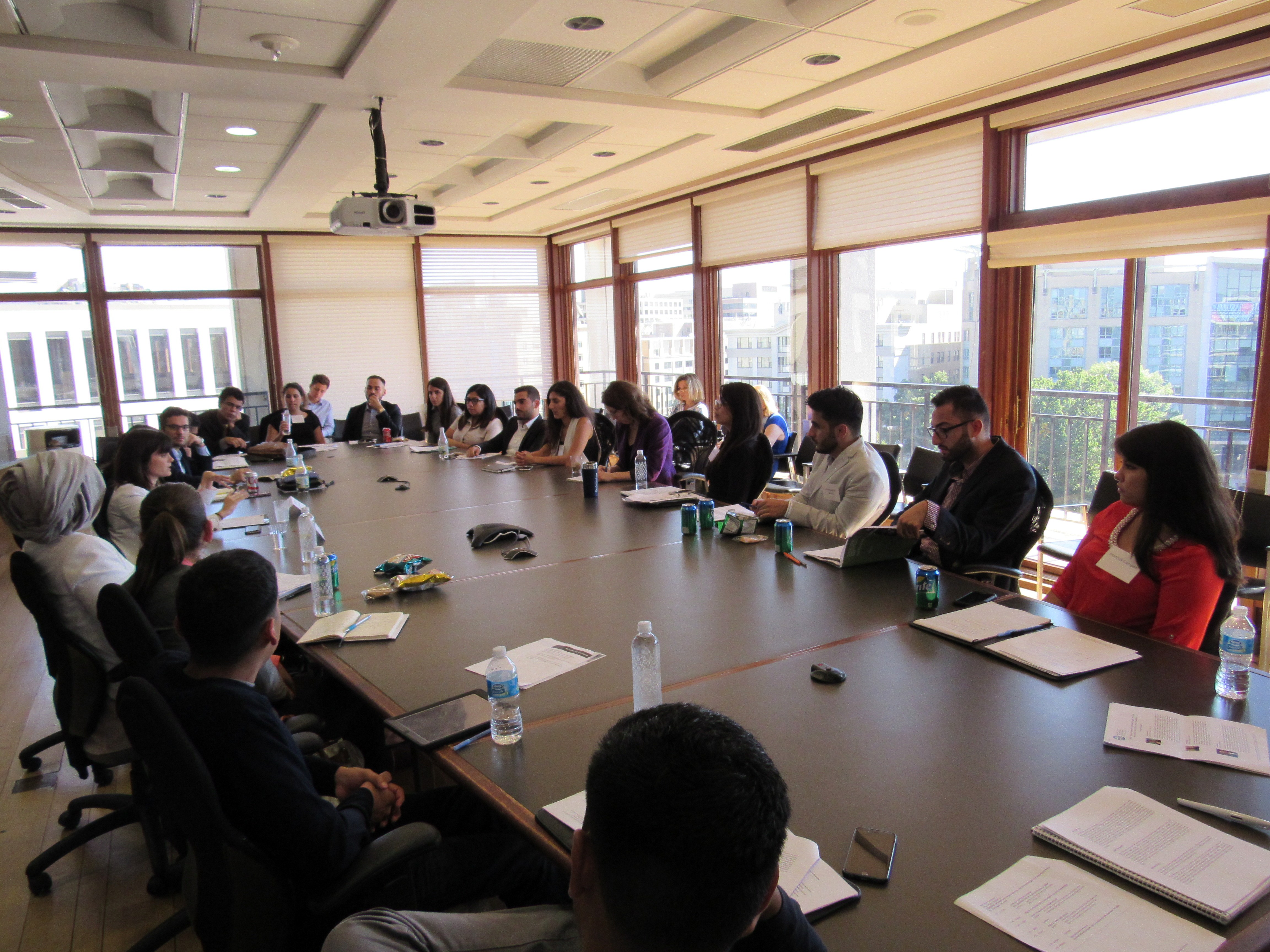
AICGS
Immigration, Integration, and a New Transatlantic Generation
Participants at the seminar engaged in small groups and interacted with leading experts from umbrella organizations dealing with immigration and integration, government, research institutions, and political foundations. They also had the opportunity to visit other institutions, including cultural/historical sites, offices of elected representatives, and non-profit associations that focus on issues of the underrepresented.
Panel 1: Integration and Immigration Issues
The panel gave an overview of immigration to the United States with a special focus on the Hispanic population in the United States. In the United States, the largest group of immigrants comes from Mexico. The panelist also gave an overview of the future demographic changes the country faces as well as the changing set-up of the immigration flow from Latin America. Today, one out of four children in the United States is Hispanic. At the current rate of demographic change, there will be no white majority in the population forty-five years from now. Unauthorized immigration from Mexico decreased and there has been an increase in apprehended immigrants from other Latin American countries. It was also stressed that American public opinion toward immigration differs depending on economic performance, country of origin, and political orientation.
In the ensuing discussion the participants were interested in the assimilation and integration of immigrants in the United States. There was a consensus that found language skills as the predominant factor for a successful integration, as well as that the value of multiculturalism has increased. The topic shifted to the aspects that burden integration, such as the high costs for the citizenship application or discrimination. Integration in the United States is taking place at the community level, and traditional receiving communities have built up a welcoming culture that helps to integrate newcomers. With a changing settling pattern of immigrants in the United States, other cities still have to adjust to a more diverse population. The panel’s participants saw a need to challenge the current existing structures of the public attitude toward newcomers in both Germany and the United States. Another focus was put on the reasons for the lack of policy changes regarding immigration in the United States and the structural barriers immigrants and Hispanics face in political participation and representation. The group emphasized media representation of immigrants and the lack of communication among different immigrant groups as further reasons for a lack in political representation.
Panel 2: Public Health and Law
The panel introduced the history of immigration in the political rhetoric. In the 1970s, immigration was framed as an economic concern, giving way to concerns about law and order and culture in the 1980s. After 9/11, the dialogue focused on terrorism and national security concerns. The recent reform debates often focus on the legal status of immigrants.
Immigration law holds a lot of complexity; after tax law, it is the most complicated law in the United States. Especially when an immigrant is involved in any criminal act, it has implications for status or for getting immigration benefits. However, unlike criminal law, violators of immigration law do not have right to legal representation. Advocates have been pushing for comprehensive immigration reforms for years. While some recent reforms have been positive (for example, recognizing the importance of low-skilled work visas), the United States still needs comprehensive reforms.
Achieving comprehensive reforms is problematic, and this has much to do with messaging. For example, despite research that shows that immigrants raise economic opportunity for natives and that crime rates among immigrants are lower than crime rates among natives, political rhetoric (especially in the current election cycle) often presents a different story. Among advocacy groups, there is the unanswered question of what story could be told, and how, to make people be in favor of migration.
There is the need for a new narrative, one reaching out to the different concerns, be they economic, security, or cultural. Only a convincing and at the same time non-biased narrative will be able to successfully address populist messages and win public support.
Panel 3: Teaching English and Bilingual Education
In the third panel, the two panelists gave insights into their work at schools in the Washington, DC, area that focus on teaching English language skills to immigrants. It was laid out how English skills lead to job opportunities and better paid jobs for immigrants. English skills are seen as the first step toward a successful integration and application for citizenship. The biggest challenge for adult immigrants is to manage two to three jobs at the same time and still attend and commit to language classes. While the improvement of language skills is a priority for immigrants, a broader range of legal services is also necessary for a successful integration.
It was pointed out that the mentality and structure to provide language classes for migrants differs in Germany and the United States. In the United States, the language schools are public schools financed through taxpayers. This is based on the idea that successful language learners pay taxes when they get access to higher paid jobs. The group from Germany reported challenges especially concerning the recent refugee crisis. In Germany, investment in language classes for refugees with an undetermined immigration status is seen as a risky investment. The participants pointed out that for refugees in Germany it is hard to use and pay for public transportation to get to their language class.
The language schools both reported diverse student bodies in DC whose students are mainly driven by the desire to learn English. Comparing the United States and Germany, the group shifted its focus toward the importance of reaching out to potential new students and to the accessibility of classes due to public transportation and gentrification in cities. The group also saw challenges in how the receiving country categorizes different groups of immigrants and is willing to expose language learners to native speakers.
Panel 4: Integration in Business: Corporate Responsibility
Demographics in the United States are shifting. In 2015, there were 57 million Hispanics in the United States, and it is projected that by 2030 Hispanics will make up one-third of the U.S. population. This means that Hispanics have big buying power within the American economy. In 2015, $1.3 trillion in buying power was controlled by Hispanics, and often it is women making the decisions about how household money is spent. The median age of the white population is 43, for Hispanics it is 28. This will have a big impact on the future workforce. The educational attainment of Hispanics has changed tremendously within the last twenty years. The dropout rate used to be at 33 percent in 1993, whereas it was at 12 percent in 2014. In addition to that, more and more Hispanics enroll in institutions after high school. These developments are building up a growing talent pool.
This data is important for companies in two senses. It has a broad and expanding base of diverse consumers to target. And that means more than translating an advertisement into Spanish. It means including a growing group of educated, talented, and diverse individuals in the company structure at all levels. Representation of Hispanics at the highest levels of companies is lacking, but with the buying power of this community and the talent they represent, it is in the private sector’s interest to hire diversity.
Regarding advice for young, diverse applicants, it was stressed to not only seek out mentors, but also sponsors. Mentors provide advice and insights into the industry. Sponsors actively promote hiring those they are sponsoring. Often, corporate culture hires types with whom they are comfortable and familiar, so it is important to have sponsors inside companies that advocate for diverse hires at all levels.
Panel 5: U.S. Elections and Immigrant Communities
The panelist introduced the need to bring more resources to the Latino community in the United States in order to enhance political participation and representation. In regard to the upcoming U.S. presidential election, the growing Latino community that is eligible to vote can evoke fear among certain electorates. With a pivotal demographic change in the United States, the discussion focused on the parties’ need to recognize the Latino population and to provide access to party engagement for Latinos. The group discussed how the outcome of the presidential election would affect the Hispanic community and concluded that the complicated system of checks and balances is most likely to prevent any immigration reform, regardless of the election outcome.
A major discussion point was the low engagement of the Hispanic community in elections. Participants noted that the narrative of “your vote does not matter” in a two party system has to change in order to get Latinos to the polls. This narrative was found to discourage a large and very particular demographic group of young first or second generation immigrants from participating. This discussion provided a crash course in U.S. politics to the German participants. The German and American participants in the group found similar challenges in their countries regarding how immigrant groups can make their voices heard in a political system that is dominated by the white population. The focus then shifted to how some universities in the United States fail to deal with increasingly multicultural student bodies. To end on a more positive note, the group refocused on the growing professional Latino community and the improvement in educational access for Latinos.
Site Visit: U.S. Citizenship and Immigration Service
There are currently 8 million people in the United States that are eligible to apply for U.S. citizenship. Even though the government embraces a positive view to see all immigrants as future citizens, the fear of the immigration test, the lack in English skills, and the fee for naturalization are considered as high obstacles for eligible immigrants. The federal government works to lessen these obstacles by providing better customer service and access to educational materials for potential citizens. Every year about 700,000 people become U.S. citizens and one million gain a permanent resident status. The numbers of applications for citizenship are increasing. Immigrants mainly originate from Latin America, the Caribbean, and Asia.
The integration of immigrants is mainly taking place on a community level in schools and at the workplace. With the changing pattern of immigrant settlement in the United States, some cities were taken by surprise by increasing immigrant populations and still need to develop welcoming communities. As an overall trend, however, cities rely on immigrants to impact the economy in a positive way. While the funding for immigration and integration is limited on the federal level, the states put more effort into immigrant integration as well as community and faith-based groups.
On the federal level, the economic, linguistic, and civic integration of immigrants is of high importance. Citizenship is promoted as the equalizer for all Americans. The work also includes a better outreach to immigrants in rural areas, the reduction of immigrant exploitation, and the development of immigrant integration plans in communities.
In the following discussion the participants were especially interested in the improvement of a better customer service of the federal government toward applicants. It was also clarified that while the fee for naturalization is a burden for many immigrants, it is a necessary service fee an applicant has to pay for his own application to be processed. The discussion also raised questions of the definition of homeland security and immigration. Participants learned that the federal approach sees a successful integration as a responsibility of the individual person’s effort.
Site Visit: Embassy of the Federal Republic of Germany
Germany views itself as an immigration destination and sees migration as a positive development. It was acknowledged that the country is still learning to deal with more diversity in its demographic set-up. Regarding Germany’s handling of the current refugee crisis, the officials acknowledged security concerns but highlighted the international respect Germany has garnered for welcoming refugees.
The discussion focused on the different definitions of integration and diversity when it comes to the German and the American point of view. There were two main differences: first, the short versus long immigration experience of Germany and the United States and, second, the government-driven versus the community-driven processes of integration in both countries. For the German participants of Turkish descent, the question of the current Turkey crisis and the experience of being Turkish in Germany was an important issue. This question led to a debate over how segregation is handled in Germany and in the United States and how loyalty to the native and the host country does not have to be mutually exclusive.
The debate shifted to political representation of immigrant groups in Germany and the government’s approach to make minorities more visible in Germany. In Germany, the integration process takes time and people with a migratory background fill political ranks slowly. The approaches toward assimilation and multiculturalism in Germany were also challenged. While the German government favors multiculturalism, it sees a need that all groups execute the rule of the German laws regarding discrimination or the equality of men and women. The discussion was concluded in agreement that the long-term development for immigration and integration in Germany is a positive one.
Site Visit: Congress
If there is one thing that both political parties can agree on in the United States, it is that the U.S. immigration system is broken. In 2013, the Gang of Eight senators (four Democrats and four Republicans) worked together to propose a bipartisan comprehensive immigration reform bill. While the bill passed in the Senate, it was not introduced in the House of Representatives. It brought immigration reform back into the spotlight, and lawmakers are hopeful that after the election, the new administration will move forward on comprehensive immigration reform. Comprehensive, rather than piecemeal, legal reforms are vital to a sustainable and effective immigration policy. If only one group benefits, it is unlikely, due to the slow-moving nature of legislation, that other groups will ever see benefits of their own.
Priorities for the office in immigration reform were border patrol, enforcement, high skilled visas, and paths to documentation and citizenship for 11 million undocumented people living in the shadows. Legal rights for those apprehended by border patrol were especially emphasized. Many are fighting for the end of private prisons, which have bad records on human rights. The Department of Justice no longer uses private prisons; however, the Department of Homeland Security (the agency in charge of immigration) still employs private prisons. Currently, those arrested for violating U.S. immigration laws are not allowed lawyers. This is especially problematic for asylum seekers and unaccompanied minors. Lawmakers are working to ensure that immigration reform includes access to counsel and ensures human rights and safety of those in custody of immigration officials.
Site Visit: Skype Call with City of Detroit Councilmember Raquel Castañeda-López
In this Skype call with the first Hispanic woman elected to Detroit’s city council, the participants got the chance to learn more about the city of Detroit, Michigan, and the work of minority representation in an elected office. The former social worker explained how she established an immigration task force with an accessible language program for the city. As a minority majority city, Detroit has a large welcoming community for newcomers.
Participants were interested in how to overcome the barriers that immigrants face when it comes to elected office. The wish to represent a community, compassion, and integrity due to immigration background were seen as the most important motivational factors to run for elected office. The panelist introduced the triangle concept for sufficient development of new policies which is a balanced approach of (1) policies, (2) grass root organizations, and (3) elected officials. In a city with a 30-40 percent poverty rate as well as unemployment, the focus shifted to Detroit’s water and housing issue as a class issue. Despite the fact that immigrants face higher obstacles, participants were motivated to engage themselves in politics and learned that adapting to the established system of policymaking and having the chance to influence policies are important skills in this field.
Site Visit: Migration Policy Institute
The final site visit focused on integration of migrant communities through education and the labor market. The American and German systems use different frameworks in both education and labor market integration. The United States education system uses a data-driven and linguistic framework when referring to immigrant students. The German system, on the other hand, has far less data on its immigrant populations, and identifies students based on the citizenship of their parents. In the German education system, a student’s “diverseness” does not go away once they learn the language, whereas in the United States a student is seen as integrated once he or she is no longer an “English language learner.” Both countries face the challenge of providing education to refugees and other marginalized groups with uninterrupted education.
The United States and Germany have different approaches to labor market integration. The United States follows the “work first” model, and Germany follows the “train first” model. The work first approach offers migrants employment, but does not offer training or allow migrants to develop skills that will allow for them to be upwardly mobile. The German train first method has a higher barrier to entry; migrants need money to support themselves and their families and often cannot afford to be involved in a training program that does not pay.
Aside from education and economic integration, migrants also need holistic support that accounts for mental health and other challenges that migrants face. This is where civil society comes into play. Civil society groups can provide support and community to newcomers and perhaps even build trust in integration and immigration systems. It is often difficult to lose sight of the full picture of the challenges that any migrant faces, and civil society is vital in welcoming migrants and providing services outside of traditional institutions.















